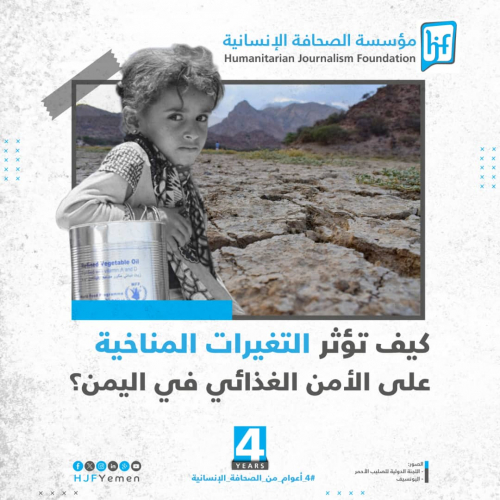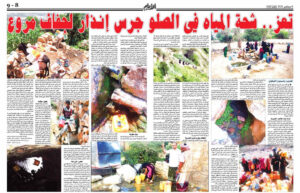Humanitarian Journalism Foundation - Bassam Al-Qadi*
This article is quoted from the Humanitarian Journalism Foundation - link to the original article published on 10/30/2023 here
“I was living with my small family in a small house that sheltered us inside our farm, through which we raised sheep, our only source of livelihood. Suddenly, we lost everything due to floods and torrents,” says Thirty-year-old Wadih El-Tohamy.
After Al-Tahami lost everything due to the floods, he was displaced from Hajjah Governorate, northwest of Yemen, to one of the camps in the “Al-Shaab” neighborhood in Al-Buraiqa District, west of the city of Aden, in southern Yemen. “Here we are dying of hunger, without water, electricity, and food,” Al-Tahami adds.

Day after day, the hunger crisis is worsening in Yemen, which has been ravaged by war for the ninth year in a row and is experiencing the worst humanitarian crisis in the world, as 2 out of every 3 people suffer from acute food insecurity, and one out of every 4 people suffers from malnutrition.
Yemen comes in second place out of 116 countries that suffer from food insecurity according to the Global Hunger Index for 2021.
As of last March, an estimated 17 million people, or about 60% of the population, face hunger, chronic food insecurity, and malnutrition, according to a recent World Bank report, as they are among the most pressing challenges in Yemen, which have been exacerbated by significant exposure to the effects of... Devastating climate change and the continuation of protracted conflict in the country.

“Climate change creates additional risks in Yemen, especially for the most vulnerable groups, and over recent years, heavy rains have led to flash floods causing deaths and widespread damage to homes, infrastructure, and crops,” the same World Bank report notes.
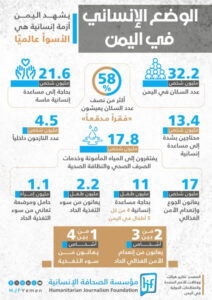
According to the United Nations, more than half of Yemen's population will continue to suffer from high levels of food insecurity, which could lead to a catastrophic situation for nearly 6 million people.
More than two-thirds of Yemen's population faces the threat of hunger, according to the FAO, and they urgently need aid to save their lives and maintain their livelihoods.
According to the Food and Agriculture Organization of the United Nations (FAO), climate change directly and indirectly affects agricultural production, due to changing patterns of rainfall, drought, floods, and the geographical redistribution of pests and diseases. Therefore, it is impossible to eradicate hunger, as part of sustainable development, without addressing climate change.”
“Levels of food insecurity in Yemen remain unprecedentedly high,” says Hussein Jadin, FAO Representative in Yemen. The latest IPC statistics indicate that more than 16 million people suffer from severe food insecurity. “The latest analysis shows no sign of improvement.”
According to Dr. Faisal Baqtada, Assistant Professor of Climatic Geography at the University of Aden, the food security situation is a major challenge for Yemen, given the current humanitarian crisis and the deteriorating economic and political conditions in the country, stressing that the living and economic situation in Yemen is already considered fragile and complex before climate changes occur, which in turn will expand The cycle of poverty and lack of social and economic stability.”

Baqtada believes that the impact of climate change on Yemen can be assessed through the decline in “food production, lack of water resources, deterioration of infrastructure, migration and loss of jobs, and that there are many measures that can be taken to improve the current situation, including enhancing local production, improving marketing and transportation, enhancing... Food safety, providing emergency food aid, in addition to promoting investment and education in the agricultural sector.
Dr. Baqtada says, “Implementing these measures requires joint efforts from the local government, non-governmental organizations and the international community. Adequate financial resources must be allocated to implement these measures and achieve sustainable food security in Yemen.”

“It can enhance resilience and mitigate the impact of climate changes on the living and economic situation in Yemen by enhancing sustainability and developing resilience in the Yemeni economy, improving infrastructure and providing basic services, in addition to implementing strategies to confront climate changes,” the assistant professor of climate geography points out.

Dr. Baqtada continues, “Responding to climate changes, adapting to them, and avoiding risks in Yemen can be done by following some 8 measures, which are awareness and education, improving infrastructure, controlling the use of natural resources, agricultural diversity, developing control and planning, strengthening government support, international cooperation, Insurance and emergency planning.
He added: “Yemen’s response to climate change and protecting food security requires developing sustainable strategies to adapt to these changes, including improving water resources management, promoting sustainable agriculture, using innovative agricultural techniques, encouraging biodiversity, and finding solutions to reduce drought and make optimal use of available resources.”

A recent study revealed that nearly 8 million Yemenis suffer from a severe lack of food security, and two million people suffer from malnutrition, and that the scarcity of water resources is the specific element that constitutes a major obstacle to developing and increasing agricultural production rates.
The study, which was published in December 2020 in the journal Annals of Agricultural Sciences in Mashtoor, included diagnosing the reality of food security and measuring the food gap in Yemen for the period from 1990 - 2019. It stressed the importance and necessity of giving sufficient attention to the food production sector to keep pace with the development of population growth in Yemen, and to provide for the needs of... Population of food.

The study confirmed that Yemen has already been affected by heat and water scarcity, and the most important reason is the rise in ground temperature, which may rise by up to 8 degrees Celsius, and this leads to a decrease in water flow by 75%, and land dryness may increase between 50% to 60%.
The main researcher of the study, Dr. Adnan Al-Sanawi, professor of agricultural economics at Sana’a University, confirmed that the agricultural sector in Yemen depends more on rainfall than on rainfall, and farmers’ lives are vulnerable to the negative effects of climate change.

He said: “Yemen faces the two biggest challenges in its modern history, the conflict between the parties and climate change, amid the complete absence of the two governments.”
He added: “Today we have a historic opportunity to adapt to these changes by following dietary patterns that are compatible with Yemeni agricultural products. Knowing that climate change is a transboundary phenomenon, it is necessary to analyze its risks within the framework of criteria to achieve sustainable development goals.”
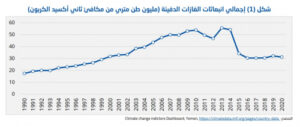
In order to mitigate the effects of climate change on Yemen, Dr. Al-Sanawi suggests increasing the size of vegetation cover and planting more trees, with individual solutions such as rationalizing energy consumption. Improved agricultural practices also contribute to reducing greenhouse gas emissions, and that the most important thing that must be done in a short period is to follow the method of adaptation and use the method of agriculture. Climate smart.
Al-Sanawi asserts, “The role of governments in Sana’a and Aden is to give greater attention to the danger of climate change, raise the level of awareness among society, and work on strategies to confront risks and not rely on development strategies that were developed in the 1980s.”

Earlier, the three United Nations agencies, the World Food Programme, UNICEF, and the United Nations Food and Agriculture Organization, said that Yemen is one of the countries that suffer most from food insecurity in the world.
According to the statement issued late last May, Yemen still needs to pay attention to the situation there, as hunger is stalking millions of people, and the situation could worsen if nothing is done to address the main drivers of food insecurity.

The Minister of Planning and International Cooperation in the internationally recognized legitimate government, Dr. Waed Badib, said that the most prominent climate impacts on food security in Yemen are what climate change has caused in recent years, including rising temperatures and changing rainfall patterns in Yemen, and causing water scarcity as a major problem affecting “Agricultural productivity and severe drought conditions reduce the availability of water for irrigation, and make it difficult for farmers to grow crops and maintain livestock, which in turn exacerbates food insecurity and contributes to malnutrition.”

“Irregular and unpredictable weather patterns, such as storms and floods, have negatively affected agricultural production in Yemen, causing losses in crop production due to soil erosion, further endangering food security and disrupting traditional growing seasons, making it difficult for farmers to plan and plant crops appropriately.” “Effective,” adds Badhib.
Badhib explained that addressing the effects of climate change on food security in Yemen requires an integrated approach, including sustainable water management, flexible agricultural practices, and an adaptation strategy, stressing that the government has benefited from the global trend to finance climate projects, and has exploited the available opportunities to achieve the necessary financing and implement Climate adaptation projects and mitigation of negative impacts on food security and the environment, despite challenges due to security conditions that limit access to financing and project implementation.

He added: “There are many projects for which funds have been mobilized in the areas of food security, water and sanitation, protection from flood damage, and the preparation of studies and mobilization for solar energy projects, which in turn aims to support climate and sustainable development projects.”

Regarding the solutions and treatments that the legitimate, internationally recognized government is supposed to implement to mitigate the aggravation of the effects of climate change on food security in Yemen, Badib answers, saying: “The government has taken many measures to mitigate the aggravation of the effects of climate change on food security, with various interventions in Improving water management and conservation measures, investing in water infrastructure, such as rainwater harvesting systems and small irrigation systems, enhancing water availability for agriculture and water efficiency practices, educating farmers on sustainable water use, establishing early warning systems, investing in improving weather monitoring and forecasting capabilities, and disseminating warnings For farmers and vulnerable communities.
A recent study on climate change and its future effects on Yemen, prepared by Dr. Ali Ahmed Dhifallah, Professor of Geography at Dhamar University, confirms that Yemen faces various environmental challenges, the most important of which is climate change, which will have a very harsh impact on the region. It suffers from a dry climate and scarcity of water sources.
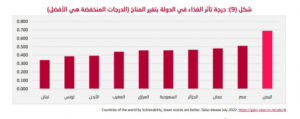
The study expected that the drought situation and the already high evaporation rate would increase in the region. “To become one of the regions most vulnerable to the effects of climate change, which in turn leads to an increase in the frequency of droughts, and then a decrease in agricultural production, and food and water insecurity.”
The study, published in the Ru’a Journal of Arts and Human Sciences in September 2020, issued by the University of Biskra in Algeria, recommended that the relevant government agencies in Yemen strive with all possible capabilities and mechanisms to provide the necessary funding to implement adaptation measures to the effects of climate change in Yemen.

In addition, the percentage of dependence on grain imports in Yemen is estimated at about 97%, and 90% of wheat products represent between 35 and 46% of the calories consumed by the individual, according to the Bulletin of Economic and Social Developments in Yemen, Issue 74, July 2022.
According to the same report, Yemen is one of the countries in the region that is greatly affected by the repercussions and effects of climate change in the world, as it relies primarily on obtaining food through importing it from other countries.

Yemen, which is among the countries that receive high climate shocks, is also considered, according to the World Bank, among the countries in the world most affected by climate change, not to mention the enormous development challenges it faces, in addition to the frequent waves of floods and droughts.
Yemen ranks “30th among the most vulnerable countries, and 17th among the countries least able to confront the effects of climate change,” and it is ranked 171st out of 182 countries on the Notre Dame Global Adaptation Index, which assesses vulnerability to climate change and readiness to adapt to it. .

Assistant Professor of Climatic Geography at the University of Aden, Faisal Baqtada, confirms that Yemen will face negative repercussions if climate change is not responded to, and that the future may witness an exacerbation of environmental, economic and social problems in the country. Confronting these challenges requires implementing concrete measures to protect water resources and enhance Sustainable agriculture, and enhancing environmental sustainability in general.
Bassam Al-Qadi is a science journalist interested in covering climate, environment and health issues

